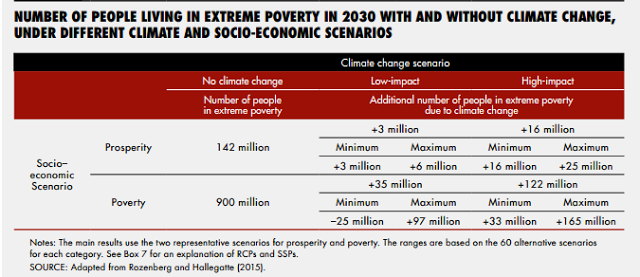Achieving the transformation to sustainable agriculture is a major challenge. Changes will need to be made in a way that does not jeopardize the capacity of the agriculture sectors crops, livestock, fisheries and forestry – to meet the world’s food needs. Global food demand in 2050 is projected to increase by at least 60 percent above 2006 levels, driven by population and income growth, as well as rapid urbanization. In the coming decades, population increases will be concentrated in regions with the highest prevalence of undernourishment and high vulnerability to the impacts of climate change.
If the world continues to achieve goals in extreme poverty reduction this will also reduce the populations vulnerable to food insecurity and hunger risks. A new World Bank study on poverty and shared prosperity says that extreme poverty worldwide continues to fall despite the lethargic state of the global economy. But it warns that given projected growth trends, reducing high inequality may be a necessary component to reaching the world’s goal of ending extreme poverty by 2030.
According to the inaugural edition of Poverty and Shared Prosperity—a new series that will report on the latest and most accurate estimates and trends in global poverty and shared prosperity annually—nearly 800 million people lived on less than US $1.90 a day in 2013. That is around 100 million fewer extremely poor people than in 2012. Progress on extreme poverty was driven mainly by East Asia and Pacific, especially China and Indonesia, and by India. Half of the world’s extreme poor now live in Sub-Saharan Africa, and another third live in South Asia.
The biggest impact agricultural technology are nitrogen fixing crops, no tilling, heat resistant crops and precision agriculture.
If per capita is higher (like the level of Portugal or Mexico) then there is no risk from climate change or food issues based on projections for the next 100 years.

Brian Wang is a Futurist Thought Leader and a popular Science blogger with 1 million readers per month. His blog Nextbigfuture.com is ranked #1 Science News Blog. It covers many disruptive technology and trends including Space, Robotics, Artificial Intelligence, Medicine, Anti-aging Biotechnology, and Nanotechnology.
Known for identifying cutting edge technologies, he is currently a Co-Founder of a startup and fundraiser for high potential early-stage companies. He is the Head of Research for Allocations for deep technology investments and an Angel Investor at Space Angels.
A frequent speaker at corporations, he has been a TEDx speaker, a Singularity University speaker and guest at numerous interviews for radio and podcasts. He is open to public speaking and advising engagements.







